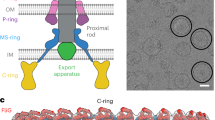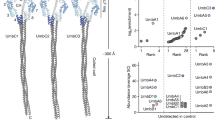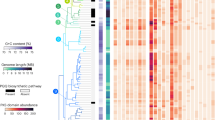Abstract
The peptidoglycan cell wall is a major protective external sheath in bacteria and a key target for antibiotics1. Peptidoglycan is present in virtually all bacteria, suggesting that it was probably present in the last bacterial common ancestor2. Cell wall expansion is orchestrated by cytoskeletal proteins related to actin (MreB) and tubulin (FtsZ)3. FtsZ is a key essential player in a highly organized division machine that directs an invaginating annulus of cell wall peptidoglycan. The recent discovery that cell-wall-less bacteria (L-forms) can grow and divide independently of FtsZ4,5, provided a means of generating an ftsZ null mutant of Escherichia coli. Remarkably, we have been able to isolate variants of E. coli that lack FtsZ but are capable of efficient growth in a walled state. Genetic analysis reveals that a combination of mutations is needed for this phenotype. Importantly, the suppressive mutations lead to a major cell shape change, from the normal cylindrical shape to a branched and bulging, ramified shape, which we call ‘coli-flower’. The results highlight the versatility of bacterial cells and illustrate possible evolutionary routes leading to the emergence of specialized bacteria, such as pathogenic Chlamydia or aquatic Planctomycetes, that lack FtsZ but retain the cell wall6–8.
This is a preview of subscription content, access via your institution
Access options
Subscribe to this journal
Receive 12 digital issues and online access to articles
$119.00 per year
only $9.92 per issue
Buy this article
- Purchase on Springer Link
- Instant access to full article PDF
Prices may be subject to local taxes which are calculated during checkout




Similar content being viewed by others
References
Schneider, T. & Sahl, H. G. Lipid II and other bactoprenol-bound cell wall precursors as drug targets. Curr. Opin. Invest. Drugs 11, 157–164 (2010).
Errington, J. L-form bacteria, cell walls and the origins of life. Open Biol. 3, 120143 (2013).
Typas, A., Banzhaf, M., Gross, C. A. & Vollmer, W. From the regulation of peptidoglycan synthesis to bacterial growth and morphology. Nature Rev. Microbiol. 10, 123–136 (2012).
Leaver, M., Dominguez-Cuevas, P., Coxhead, J. M., Daniel, R. A. & Errington, J. Life without a wall or division machine in Bacillus subtilis. Nature 457, 849–853 (2009).
Mercier, R., Kawai, Y. & Errington, J. General principles for the formation and proliferation of a wall-free (L-form) state in bacteria. eLife 3, 04629 (2014).
Pilhofer, M. et al. Discovery of chlamydial peptidoglycan reveals bacteria with murein sacculi but without FtsZ. Nature Commun. 4, 2856 (2013).
Liechti, G. W. et al. A new metabolic cell-wall labelling method reveals peptidoglycan in Chlamydia trachomatis. Nature 506, 507–510 (2014).
Jeske, O. et al. Planctomycetes do possess a peptidoglycan cell wall. Nature Commun. 6, 7116 (2015).
Kawai, Y., Mercier, R. & Errington, J. Bacterial cell morphogenesis does not require a preexisting template structure. Curr. Biol. 24, 863–867 (2014).
Ranjit, D. K. & Young, K. D. The Rcs stress response and accessory envelope proteins are required for de novo generation of cell shape in Escherichia coli. J. Bacteriol. 195, 2452–2462 (2013).
Billings, G. et al. De novo morphogenesis in L-forms via geometric control of cell growth. Mol. Microbiol. 93, 883–896 (2014).
Dai, K. & Lutkenhaus, J. ftsZ is an essential cell division gene in Escherichia coli. J. Bacteriol. 173, 3500–3506 (1991).
Paradis-Bleau, C. et al. Lipoprotein cofactors located in the outer membrane activate bacterial cell wall polymerases. Cell 143, 1110–1120 (2010).
Typas, A. et al. Regulation of peptidoglycan synthesis by outer-membrane proteins. Cell 143, 1097–1109 (2010).
Gray, A. N. et al. Coordination of peptidoglycan synthesis and outer membrane constriction during Escherichia coli cell division. eLife 4, 07118 (2015).
Braun, V. & Bosch, V. Repetitive sequences in the murein-lipoprotein of the cell wall of Escherichia coli. Proc. Natl Acad. Sci. USA 69, 970–974 (1972).
Sambrook, J., Fritsch, E. F. & Maniatis, T. Molecular Cloning: A Laboratory Manual (Cold Spring Harbor Laboratory Press, 1989).
Datsenko, K. A. & Wanner, B. L. One-step inactivation of chromosomal genes in Escherichia coli K-12 using PCR products. Proc. Natl Acad. Sci. USA 97, 6640–6645 (2000).
Jensen, R. B., Grohmann, E., Schwab, H., Diaz-Orejas, R. & Gerdes, K. Comparison of ccd of F, parDE of RP4, and parD of R1 using a novel conditional replication control system of plasmid R1. Mol. Microbiol. 17, 211–220 (1995).
Shen, Z. et al. MPprimer: a program for reliable multiplex PCR primer design. BMC Bioinformatics 11, 143 (2010).
Acknowledgements
The authors thank T. Mignot for hosting parts of the work in his laboratory, W. Vollmer for the gift of the plasmid pBAD33-lpoB and comments on the manuscript, H. Strahl and L. Espinosa for discussions and D.W. Adams for critical reading of the manuscript. This work was funded by European Research Council Advanced Investigator Grants (nos 250363 and BH141574) to J.E.
Author information
Authors and Affiliations
Contributions
R.M. designed and performed the experiments. R.M. and Y.K. analysed the data. R.M. and J.E. wrote the manuscript.
Corresponding authors
Ethics declarations
Competing interests
The authors declare no competing financial interests.
Supplementary information
Supplementary Information
Supplementary Data 1–4, Supplementary Figures 1–8, Supplementary Tables 1–3, Supplementary References (PDF 7045 kb)
Supplementary Video 1
Time-lapse series showing ΔftsZsup5 cells growing on NA 20mM Mg2+, from which the panels in Figure 2b were obtained. Phase contrast images were acquired automatically every minute for about 279 min. Scale bar is 3 μm. (AVI 1117 kb)
Supplementary Video 2
Time-lapse series showing ΔftsZsup1 cell growing on NA 20mM Mg2+, from which the panels in Figure 2b were obtained. Phase contrast images were acquired automatically every minute for about 279 min. Scale bar is 3 μm. (AVI 2475 kb)
Supplementary Video 3
Time-lapse series showing ΔftsZsup7 cell growing on NA 20mM Mg2+. Phase contrast images were acquired automatically every minute for about 109 min. Scale bar is 3 μm. (AVI 810 kb)
Supplementary Video 4
Time-lapse series showing ΔftsZsup7 cell dividing on NA 20mM Mg2+, from which the panels in Figure 2b were obtained. Phase contrast images were acquired automatically every minute for about 69 min. Scale bar is 3 μm. (AVI 297 kb)
Supplementary Video 5
Time-lapse series showing ΔftsZsup7 cell dividing on NA + 20mM Mg2+, from which the panels in Figure 2c were obtained. Phase contrast images were acquired automatically every minute for about 90 min. Scale bar is 3 μm. (AVI 419 kb)
Supplementary Video 6
Time-lapse series showing RM445 (ΔftsZ/Δlpp/ΔlpoBsup) cell, bearing the plasmid pBAD33-lpoB cell growing on NA + 20mM Mg2+ref with glucose (lpp expression repressed). Phase contrast images were acquired automatically every minute for about 209 min. Scale bar is 3 μm. (AVI 3149 kb)
Supplementary Video 7
Time-lapse series showing RM445 (ΔftsZ/Δlpp/ΔlpoBsup), bearing the plasmid pBAD33-lpoB cell growing on NA + 20mM Mg2+ with lpoB expression induced (arabinose), from which the panels in Figure 3d were obtained. Phase contrast images were acquired automatically every minute for about 209 min. Scale bar is 3 μm. (AVI 3477 kb)
Rights and permissions
About this article
Cite this article
Mercier, R., Kawai, Y. & Errington, J. Wall proficient E. coli capable of sustained growth in the absence of the Z-ring division machine. Nat Microbiol 1, 16091 (2016). https://doi.org/10.1038/nmicrobiol.2016.91
Received:
Accepted:
Published:
DOI: https://doi.org/10.1038/nmicrobiol.2016.91
This article is cited by
-
Cell division in the archaeon Haloferax volcanii relies on two FtsZ proteins with distinct functions in division ring assembly and constriction
Nature Microbiology (2021)
-
Rod width under control
Nature Microbiology (2019)
-
Hybrid cell reactor system from Escherichia coli protoplast cells and arrayed lipid bilayer chamber device
Scientific Reports (2018)
-
Novel bacteriocyte-associated pleomorphic symbiont of the grain pest beetle Rhyzopertha dominica (Coleoptera: Bostrichidae)
Zoological Letters (2017)
-
A mechanism for FtsZ-independent proliferation in Streptomyces
Nature Communications (2017)



